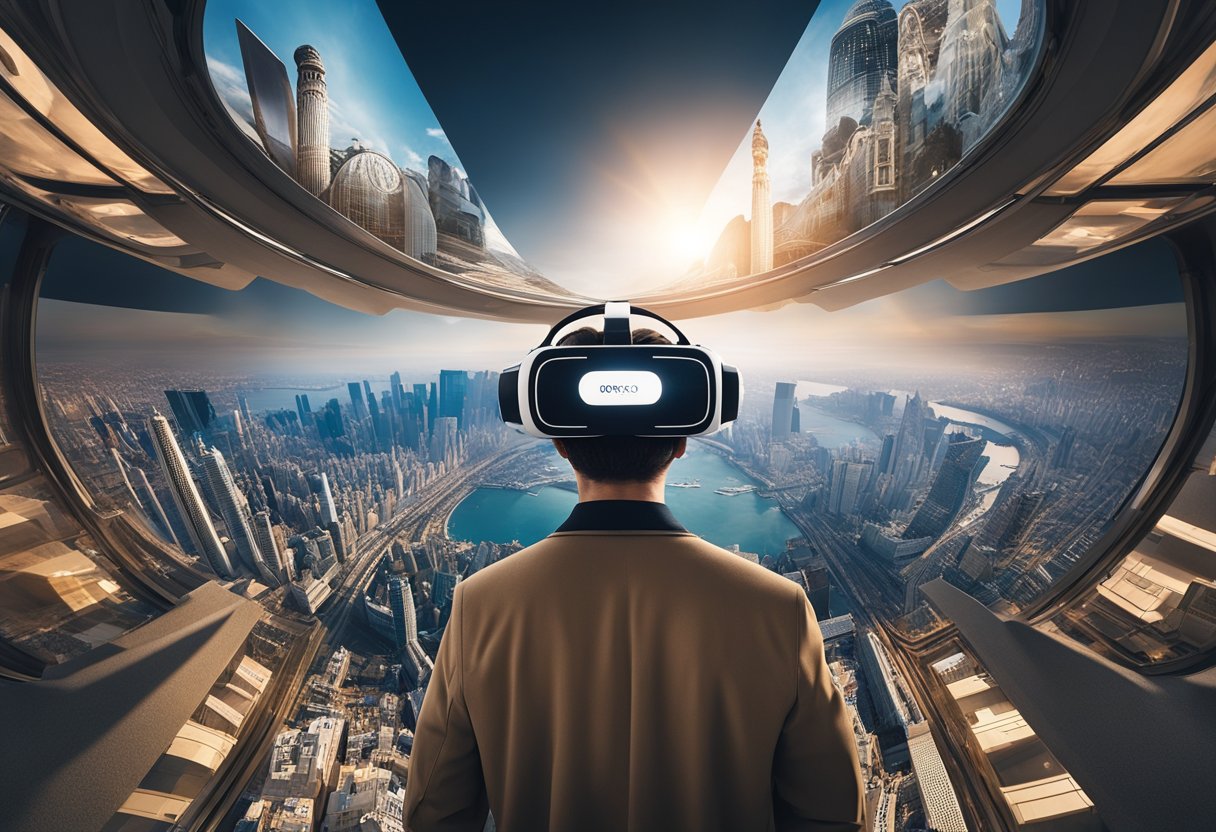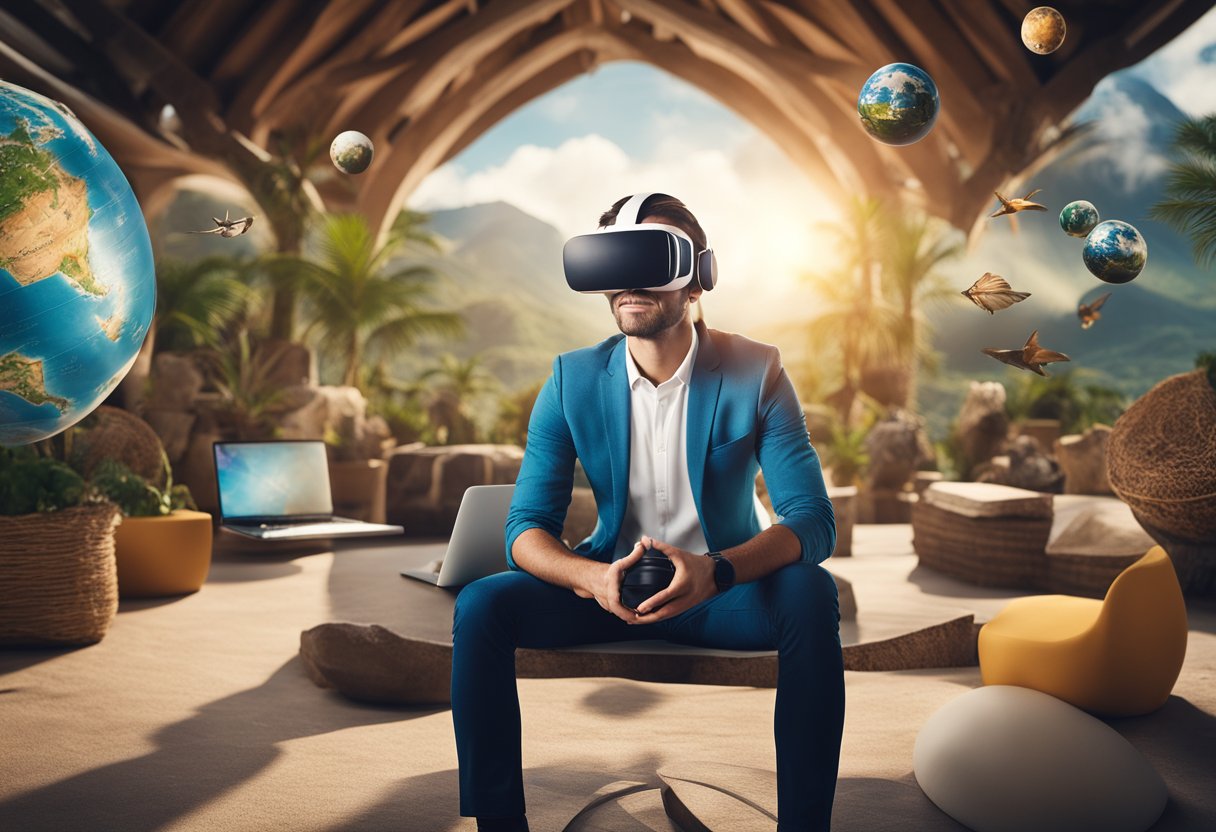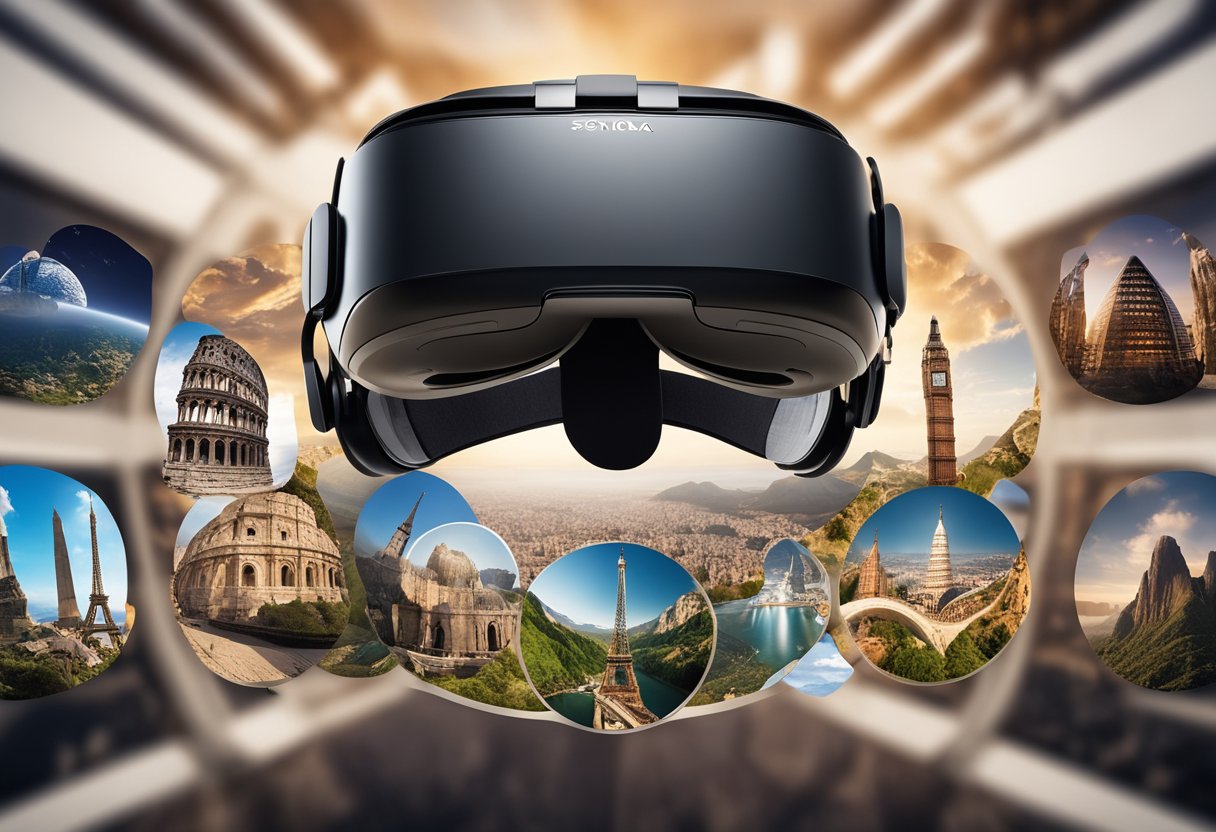Virtual Reality Travel: Discover the Globe from Your Beloved Living Room

Updated On: April 07, 2024 by Fatma Mohamed
Exploring diverse cultures and experiencing the wonders of the world requires physical travel. However, virtual reality travel makes adventure accessible from the comfort of one’s own home. It offers the curious and the intrepid the opportunity to immerse themselves in distant lands and iconic locations without the constraints of budget or the need for extensive planning.

Adopting VR for travel is more than a novelty—it is a burgeoning industry offering boundless educational, recreational, and cultural experiences. With a suitable VR headset, one can stroll through the historic streets of European capitals, partake in the grandeur of natural phenomena, and soak in the cultural richness of heritage sites across the globe. This technology serves not only as a new marketing horizon for the tourism industry but also as a testament to how technological advancements are redefining our very notions of exploration and travel.
Table of Contents
The Emergence of Virtual Reality Travel
Virtual reality travel has revolutionised the way we experience the world, enabling us to explore distant places and cultures without the need to physically travel. Not only does this incredible technology provide a sustainable alternative to traditional tourism, but it also unlocks the door to countless educational opportunities and adventures.
Historical Development
Virtual reality (VR) travel has rapidly progressed from a concept to a widely accessible form of entertainment and education. Initially, VR was seen primarily as an extension of video gaming, with platforms like the Oculus Rift and HTC Vive spearheading the early stages of immersive virtual experiences. However, as the technology has advanced, so too has its application, and virtual travel has become a particularly enticing development. It offers users the chance to walk the streets of Paris, soar over the Grand Canyon, or delve into the depths of the ocean, all from the comfort of their living rooms.
The Technology Behind Virtual Travel
At the heart of virtual travel are powerful VR headsets such as the Meta Quest, previously known as Oculus Quest, which combine high-resolution displays, precise tracking, and a wide field of view to create a truly immersive experience. By donning these headsets, we can instantly transport ourselves to virtual worlds that are either recreations of real-life locations or fantastical environments that exist only in our imaginations. This is facilitated by complex algorithms and state-of-the-art computer graphics that bring these destinations to life with remarkable realism. The technology behind virtual travel continues to evolve, offering ever more authentic and engaging adventures as it does so.
Choosing the Right VR Headset
When stepping into the world of virtual reality, the choice of headset is paramount. It will define the clarity, comfort, and overall immersive experience of your virtual travels.
Types of VR Headsets
Standalone Headsets: These devices, like the Meta Quest 3, are self-contained systems that don’t require a PC or smartphone. They’re wireless, user-friendly, and perfect for those who value convenience and portability.
PC-Connected Headsets: Such as the Oculus Rift and HTC Vive, offer high-quality, immersive experiences. They require a powerful PC to operate but provide superior graphics and tracking capabilities.
Smart Glasses: Highlighting the crossover between augmented reality (AR) and VR, smart glasses like the Apple Vision Pro blend real-world and digital content for a mixed experience.
Considerations for Purchase
When purchasing a VR headset, it’s essential to weigh several factors:
- Resolution & Field of View: High-resolution displays with a wide field of view are crucial for an immersive VR experience.
- Comfort: Look for a headset with an ergonomic design and adjustable straps to ensure comfort during extended use.
- Content Availability: Verify the variety of travel experiences supported by the headset’s platform.
- Price: Standalone headsets like the Meta Quest 3 offer a middle-ground in terms of price versus performance, while premium PC-connected models can be more costly.
- Hardware Requirements: For PC-connected headsets, ensure your computer has the necessary specs to support them.
Exploring Cities and Landmarks Virtually

Virtual reality travel experiences transport us to some of the world’s most iconic cities and landmarks without the need for physical travel. Leveraging technology such as Google Earth VR, these virtual tours provide immersive 360-degree panoramas, allowing us to explore destinations in rich detail.
Visiting Iconic Cities
We can virtually stroll through the vibrant streets of Paris, experiencing the City of Lights with its historic architecture and bustling cafes. From the comfort of home, we immerse ourselves in Japanese culture and the futuristic skyline of Tokyo, thanks to virtual reality platforms offering an array of urban experiences.
Touring Famous Landmarks
The majestic Taj Mahal can be admired in full splendour, marvelling at the intricate craftsmanship and solemn beauty through a virtual lens. Similarly, the engineering marvel of the Eiffel Tower is now just a few clicks away. We cross continents to gaze upon the rugged grandiosity of the Grand Canyon, experiencing its geological wonders up close through vivid virtual tours.
Immersive Nature and Adventure Experiences
Venture into some of the most spectacular landscapes and thrilling experiences nature has to offer without ever packing a suitcase. With virtual reality (VR), we now have the opportunity to explore natural wonders and embark on adrenaline-pumping adventures right from our living rooms.
Virtual National Parks
Experience the awe-inspiring vistas of national parks around the globe through the lens of VR. From the towering red rock formations of the Grand Canyon to the serene beauty of Yellowstone, these virtual tours offer a taste of the world’s most iconic national parks. You can traverse hiking trails digitally, immersing yourself in the sights and sounds of these treasured landscapes, witnessing scenarios you might never have the chance to in person.
Thrilling Virtual Adventures
For those of us seeking excitement, virtual reality delivers thrilling virtual adventures that rival the real thing. Imagine engaging in a safari where you’re up close with the wild, or mountain climbing through challenging terrains of Everest—all achieved through high-definition VR experiences. Submerge into the depths of the ocean with scuba diving simulations that unveil the mystique of underwater life in the Great Barrier Reef, or soar above it all in a hang-gliding journey around the world’s most breathtaking natural wonders.
Cultural Heritage and Educational Tours

Venturing into the world of virtual tours allows us to explore global cultural heritage and educational content from the comfort of our own homes. We can traverse museums and historic sites across continents, gaining insights and knowledge typically constrained by physical borders.
Museum Exploration
We are now at the forefront of a revolution that takes museum exploration beyond the physical confines of buildings. Through virtual museum tours, we can teleport to institutions teeming with culture and history. For instance, a person can marvel at the famed exhibits of the Louvre without stepping foot in Paris or admire the Rosetta Stone at the British Museum by simply using a web-enabled device. These immersive experiences ensure that education and appreciation of global heritage are accessible to all.
Historical Reconstructions
The past comes alive with historical reconstructions in virtual reality (VR). Recreating ancient cities such as Rome now becomes a detailed, interactive journey with platforms like National Geographic Explore VR, where users can wander through the Roman Forum or stand in the heart of St. Peter’s Basilica. This immersive education allows us to witness history unfold, providing a comprehensive understanding of the wonders of ancient civilizations and the foundations of our cultural heritage.
Virtual Reality in Tourism Marketing
Virtual Reality (VR) has revolutionised the way we promote destinations and engage prospective tourists, offering a tantalising glimpse of travel experiences from the comfort of one’s own home.
Promoting Destinations
With VR, we can immerse travellers in the sights and sounds of a place, even before they book their tickets. For instance, tourism boards create interactive travel shows that allow people to explore landmarks, hear the local soundscape, and learn about cultural highlights. This innovative approach to marketing has become particularly advantageous in circumstances where travel is restricted. The Japan National Tourism Organization, seizing the opportunity provided by the postponed 2020 Olympics, developed a 360-degree virtual tour showcasing stunning locations across the nation.
Engaging Potential Tourists
Virtual tourism is not just about showing a destination; it’s about engaging the viewer and making them feel present in the location. VR brings an interactive element to traditional marketing materials by showcasing virtual guided tours where users make decisions about where to go and what to see. It allows us to foster a connection with the destination, leading to a greater likelihood of converting virtual travellers into actual visitors. For example, the Faroe Islands offer a virtual tourism experience whereby individuals are practically placed in the serene, rugged landscapes of the North Atlantic. Virtual tourism can rebuild travel for a post-pandemic world, fostering a sense of exploration and adventure.
Through these strategies, we aim to excite, entice, and educate potential travellers about the myriad possibilities awaiting them around the globe. Virtual reality in tourism marketing is not just about visibility; it’s about creating a connection that spurs the wanderlust within and eventually leads to a suitcase being packed for the next adventure.
The Technological Backbone of Virtual Tourism
The fabric of virtual tourism is held together by a mesh of innovative technologies that provide immersive experiences from the comfort of our homes. Let’s explore the critical tech that powers this modern travel phenomenon.
Internet Connectivity
At the heart of virtual travel is the quintessential need for a reliable internet connection. It is the pipeline that streams the world into our living rooms. High-speed broadband is preferred, as it ensures smooth streaming of high-quality virtual environments, reducing buffering and loading times to a minimum. In circumstances where an internet connection may be restricted, a VPN can be a handy tool to bypass geographical limitations, providing access to a broader range of virtual tours. Ensuring a robust and secure internet connection is vital to experiencing virtual tourism without technical disruptions.
Augmented Reality Enhancements
Augmented reality (AR) takes virtual travel a step further by overlaying digital information onto our physical surroundings. This technology embeds additional layers of interaction and engagement by superimposing images, sounds, and tactile feedback into real-world contexts, which can be accessed using AR glasses or through our smartphones’ screens. The enhancements made possible by AR technology transform the viewing experience into an interactive journey, allowing us to interact with the environment like never before, providing a deeper connection with destinations we’re exploring virtually.
Specialised Virtual Travel Experiences
As we continue to innovate the way we explore the world, specialised virtual travel experiences have emerged, allowing us to transcend physical limitations and immerse ourselves in new environments from the comfort of our homes. Through powerful virtual reality (VR) technology, these experiences bring destinations and scenarios to life with remarkable realism.
Guided Meditation through VR
Embark on a journey inward with Guided Meditation VR, a virtual reality application that leads you through tranquil settings accompanied by soothing audio guidance. This experience offers a unique way to meditate, as you can choose various serene locales that would otherwise be inaccessible. Float amidst the stars or sit beside a cascading waterfall, all while guided by a calm voice that directs your breath and focus, helping you to achieve a state of deep relaxation and mindfulness.
Underwater and Marine Journeys
Explore the hidden depths of our oceans without getting wet. theBlu is a breathtaking VR experience that introduces you to the vivid marine life that lies beneath the waves. Encounter the majesty of the underwater world as you swim with manta rays, marvel at the silent dance of jellyfish, and face the grandeur of a blue whale. These underwater and marine journeys provide an educational and awe-inspiring experience, expanding our appreciation for the undersea ecosystems and the creatures that inhabit them.
Accessing Virtual Reality Travel Content
With virtual reality (VR) technology, we can now explore the world from the comfort of our homes. Let’s dive into the platforms and applications that make this possible, as well as how we can stream virtual experiences to broaden our horizons.
Platforms and Applications
Google Earth and Google Street View are leading platforms that allow us to virtually travel the globe. Using detailed satellite imagery and street-level photographs, we can visit famous landmarks, navigate cities, and experience natural wonders. These applications are accessible through various VR headsets and devices, making it possible to enjoy a truly immersive experience.
For those with a Meta Quest headset, the Meta Quest blog suggests a selection of 11 VR apps and films that enable us to travel virtually. Adventure seekers can discover a range of experiences curated for exploring different parts of the planet without needing to step outside.
Streaming Virtual Experiences
Streaming platforms such as Netflix have started offering virtual travel experiences which are accessible on VR devices. This enables us to enjoy the thrills of travel documentaries and series with an added layer of immersion, sometimes delivering 360-degree video content that places us right in the scene.
By harnessing VR technology, we’re no longer limited by geography or physical constraints. Whether we’re roaming the streets of a foreign city through Google Street View or embarking on a thematic journey with Netflix, the possibilities are endless. We can savour the world’s beauty in a sustainable manner, respecting the distinctiveness of each place we ‘visit’ virtually.
Practical Considerations for Virtual Travellers

As we delve into the realm of virtual reality (VR) travel, we should keep in mind important practical considerations. VR technology can transport us to far-flung destinations from the comfort of our homes, but ensuring a seamless experience requires attention to certain details.
Ensuring Compatibility
Before we embark on our virtual journey, compatibility is key. We must verify that our VR hardware and software are compatible with the virtual travel experiences we wish to enjoy. For instance, certain travel apps may only be available on specific VR platforms like the Oculus Quest or HTC Vive. Some virtual experiences might require a high-end graphics card or a particular operating system to function effectively. It’s, therefore, crucial that we check the requirements of our intended virtual travel applications and ensure our existing equipment meets these specifications.
Budget and Costs
Budgeting for VR travel is quite different from traditional travel. Initially, there may be a higher upfront cost to purchase the necessary VR technology. Prices for headsets and accessories can vary significantly, ranging from affordable options to premium devices. After the initial investment, virtual travel experiences themselves are often low-cost or even free. We can hunt for budget-friendly VR travel apps that transport us to virtual worlds, offering cost-effective ways to explore new destinations. By considering these expenses, we are better equipped to balance our budget and costs with our desire to explore the world through VR.
The Future of Virtual Travel
Virtual Reality (VR) travel has dramatically shifted the way we explore the world, providing immersive experiences from the comfort of home. In the coming years, this burgeoning field is poised to redefine tourism and global exploration.
Trends and Predictions
In the realm of virtual reality travel experiences, one can anticipate further integration of sensory elements to enhance immersion. We expect to see a surge in haptic feedback technologies, allowing us to not only see and hear but also feel the environments we visit virtually. Social VR travel will likely become more prevalent as platforms enable travellers to share experiences with friends and family in real time, regardless of physical distance.
Technology improvements in VR hardware, such as more lightweight and wireless headsets, will make virtual travel even more accessible and comfortable. Moreover, the rise of 5G networks will allow for smoother and more detailed VR experiences, alleviating issues of latency and enabling more intricate renderings of distant locales.
Potential Developments
We foresee significant potential developments in the intersection of virtual reality and tourism. Real-world scanning techniques, such as photogrammetry and Lidar, are set to become more sophisticated, offering higher fidelity in recreating destinations. This progress will enable us to virtually wander through locales that are replicas of their physical counterparts down to the smallest detail.
Additionally, machine learning algorithms will play a crucial role in personalising virtual travel. They will recommend destinations and curate experiences based on our preferences and past behaviour, providing bespoke adventures tailored specifically for us. The boundary between actual and virtual will blur as these technologies advance, making virtual globetrotting an integral part of how we learn about and connect with the world.
Frequently Asked Questions

We are often asked various questions about virtual reality and its applications in experiencing global travel from home. In this section, we address some of these queries to help you better understand virtual reality travel.
What are the top-rated virtual reality applications for global exploration?
Among the top-rated virtual reality applications, some offer immersive explorations like Google Earth VR, allowing users to soar over cities and discover new landscapes across the globe. Another is Wander, which utilises Google Street View imagery.
How can elderly users engage with virtual reality to experience travel?
Elderly users can engage with virtual reality travel through user-friendly platforms that provide simplified controls and comfortable headsets. Applications like Alcove VR are designed to cater to older adults, offering a gateway to virtual travel adventures in a hassle-free environment.
Which virtual reality travel experiences are available for free?
Several virtual reality travel experiences are accessible at no cost, such as the VR experiences listed on the Meta Quest Blog, which include nature documentaries and cultural tours, enabling users to globe-trot without spending a penny.
Can you recommend any virtual reality games that simulate world exploration?
Yes, there are virtual reality games that simulate world exploration, like The Wanderer: Frankenstein’s Creature, which allows you to experience historical settings, and National Geographic Explore VR, for adventure travels.
What are the best VR travel experiences specifically for Oculus Quest 2?
For Oculus Quest 2, some of the best VR travel experiences include the visually stunning Wander, and games like National Geographic Explore VR, offering engaging adventures in exotic locations.
How does virtual reality allow users to experience travel from the comfort of their homes?
Virtual reality enables users to experience travel from home by providing immersive visual and often interactive content that makes them feel as though they’re actually exploring a different location, be it a city, nature reserve, museum, or a completely imagined environment.






